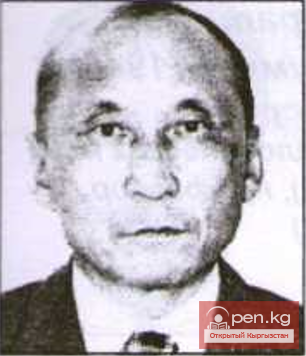IN HONOR OF THE HERO CITY OF MOSCOW
This is one of the busiest streets in the city. Stretching from the Alamedin River to Fuchik Street, it is spacious, lined with greenery, and bears no resemblance to the dusty street that was once called Iskakovskaya. Before the revolution, there were the same mud huts in the Dunganovka area, and nice single-story mansions on a brick foundation belonging to wealthy residents in the eastern part of the street. Some of them can still be seen today - some have survived to this day.
According to the memories of S. D. Zhevakin, an active participant in the revolution and civil war, who was the commander of the garrison in Pishpek, in one of the houses (unfortunately, not yet identified) on this street, in late June 1920, the authorized representative of the Revolutionary Military Council of the Turkfront, D. A. Furmanov, stayed for several days while visiting Pishpek on official business after suppressing the Verny uprising. Here, D. A. Furmanov wrote several draft pages of the novel "The Uprising".
In the pre-war years, the first two-story houses appeared on it. The paving of the street with cobblestones began.
In the early post-war years, the construction of two-story houses continued. About two dozen houses were built, including the building of the P. F. Shubin Children's Music School, a technical school, and several others.
In September 1951, on a vacant lot where the city garbage dump had been in the post-war years, planning work began, followed by the planting of trees and shrubs. Thus, a park began to take shape. On an area of 3.6 hectares, 37 species of plants were planted. The central alley runs from south to north. On both sides, two rows of trees were planted. The first row consists of eastern biota, and the second of mixed species: oak, catalpa, gleditsia, and acacia.
Along the alleys between the trees, shrubs were planted. In total, the park contains 2,102 specimens of various plants. The floral decoration is concentrated along the Central Alley. Here, there are roses, phloxes, irises, and peonies.
In June 1960, in connection with the 100th anniversary of the birth of the national akyn of Kyrgyzstan Togolok Moldo, the park was named after him. In 1963, a bust monument to the akyn, created from solid pink granite by the People's Artist of the Kyrgyz SSR, sculptor O. M. Manuilova, was installed at the center of the intersection of the main and additional alleys. Today, the park is one of the favorite places for workers to relax.
In 1957, at the corner of Gorky Street, a store called "Children's World" opened in a multi-story building, which was later transformed into a store for men's goods - "Er-Korku". (Currently a "Commission Shop").
In the late 1950s and 1960s, 3, 4, and 5-story residential, administrative, and public buildings appeared on the street.
In 1908, between Belinsky and Turusbekov Streets, the design institute "Kyrgyzgiproselkhoz" was located in a 5-story building, which was later transformed into the Central Research Institute of Sheep Industry (architect G. Kutateladze). Large stores opened in multi-story residential buildings - "Tulpar" for automotive and motorcycle technology, the grocery store "Berekе", and the "Cultural Goods" store.
Significant work was carried out to improve the roadway of the street - it was widened and asphalted along its entire length. A trolleybus line was established.
In 1924, Iskakovskaya Street was renamed Pioneer Street, and in 1954 - the year of the celebration of the 300th anniversary of the reunification of Ukraine with Russia - Pioneer and Dungan Streets were renamed in honor of this event - the first to Moscow Street and the second to Kyiv Street.
In 1932, a meat processing plant was commissioned on a vacant lot at the end of the street, with an initial production capacity of 22,000 tons of meat, 3,000 tons of sausage products, and 20,000 cans of canned goods. Now the plant produces 100,000 tons of meat and 28,000 tons of sausage products daily.
Moscow Street is being developed more slowly than other streets running through the city center. Among the notable recent events in its biography, the construction of multi-story residential buildings, a republican consulting clinic for participants of the Great Patriotic War, and an aesthetic center can be highlighted. The last two facts deserve special attention. Protecting the health of former front-line soldiers is the primary concern, a sacred duty of Soviet people. In our republic, as in the whole country, this matter is given great importance. About 50,000 participants have been placed on special medical records. The building is a small two-story structure clad in white marble.
The aesthetic center is located at the intersection of Shopokov and Moscow Streets, on the first floor of a residential building.
Here, schoolchildren, under the experienced guidance of specialists, learn the techniques of making various samples of folk applied art, engage in visual creativity, etc. The center is designed to actively participate in shaping the aesthetic tastes of the younger generation and to awaken their interest in creativity.
In the multi-story residential building No. 141 opposite the Togolok Moldo Park lived the People's Artist of the Kyrgyz SSR Vyacheslav Fedorovich Kazakov (1913-1979), who worked at the Russian Drama Theater named after N. K. Krupskaya since 1935, from the time of the theater's organization. The artist played more than 200 roles. He was the first to create the image of V. I. Lenin on stage in Kyrgyzstan in the play "Unforgettable 19th" (1952), as well as in the plays "Family", "Kremlin Chimes", and others. For his contributions to the development of theatrical art, V. F. Kazakov was awarded the Order of Lenin and other orders. He was elected as a deputy of the Supreme Soviet of the Kyrgyz SSR of the 7th and 8th convocations.
A memorial plaque with a bas-relief has been installed on the house where he lived.
Losev D. S., Kochkunov A. S. What the Streets Tell
Streets of Bishkek















































